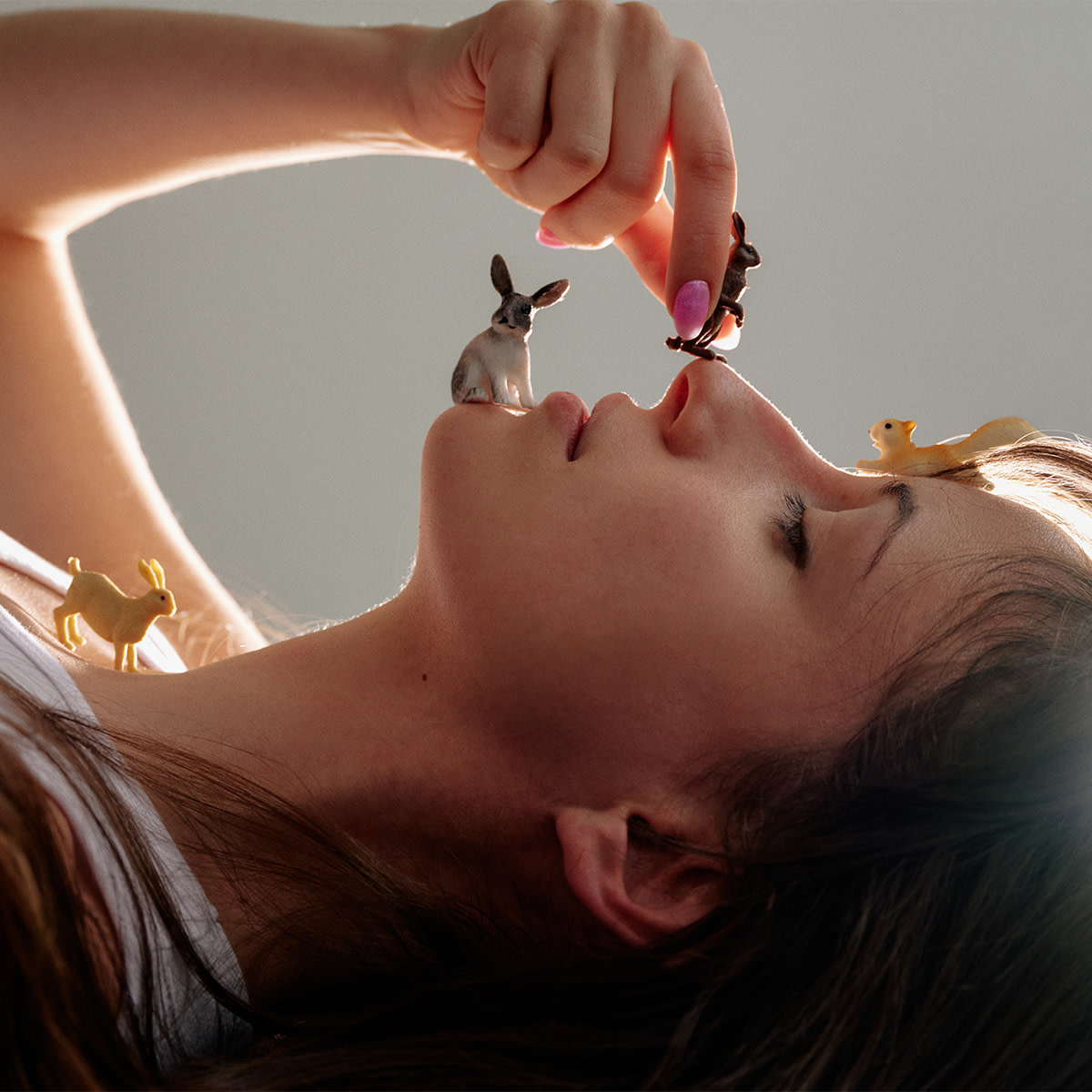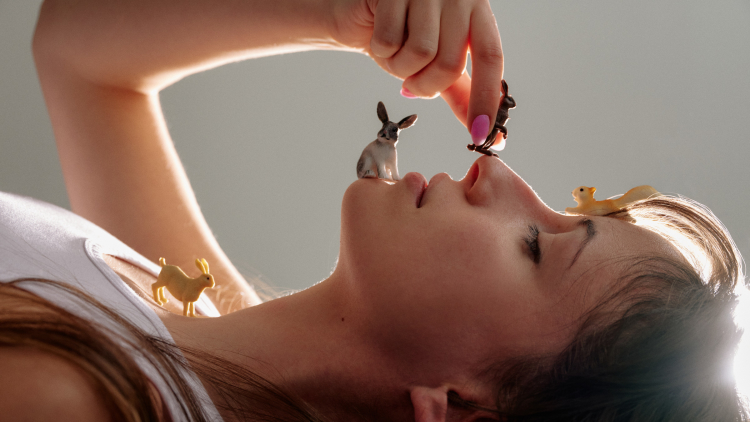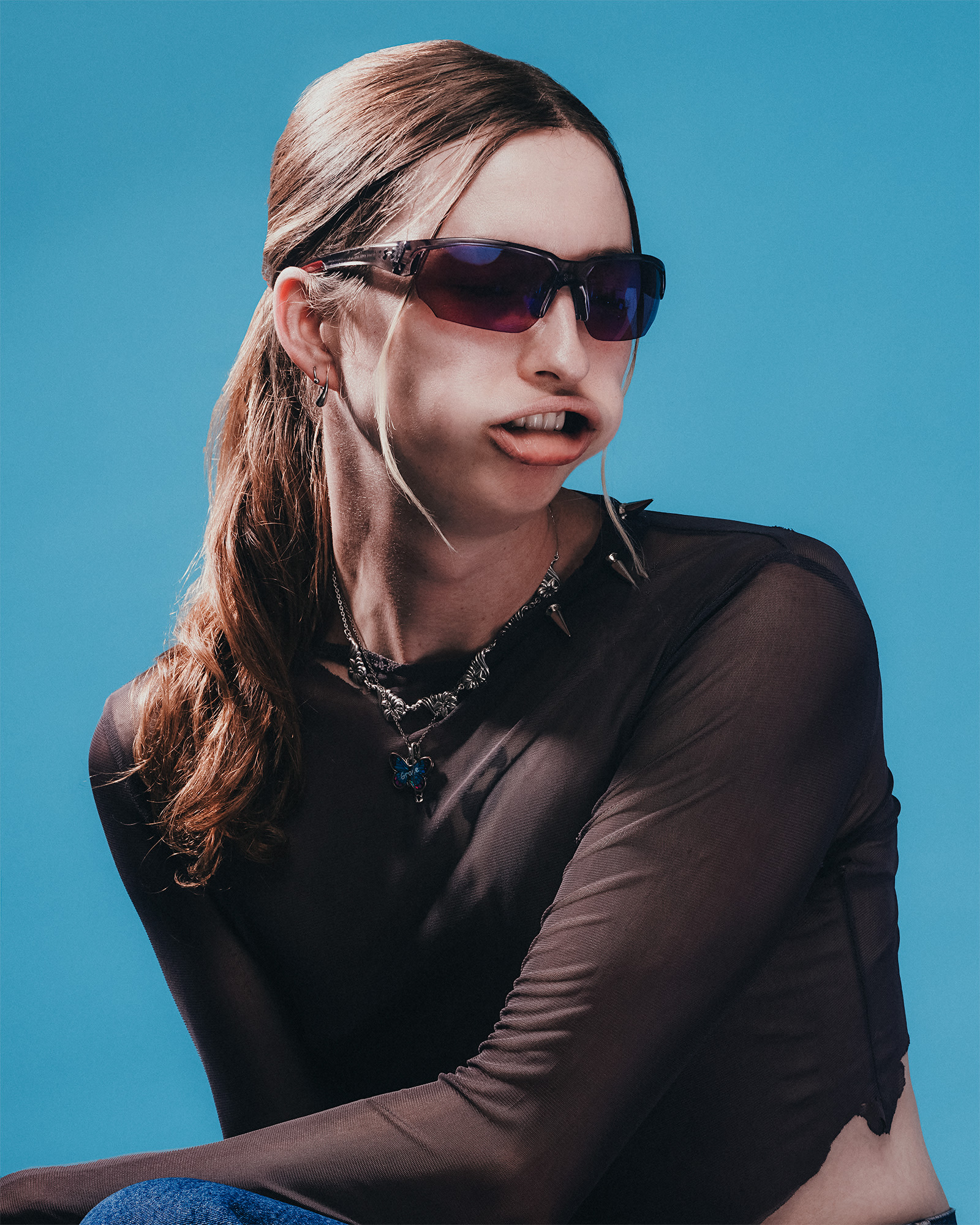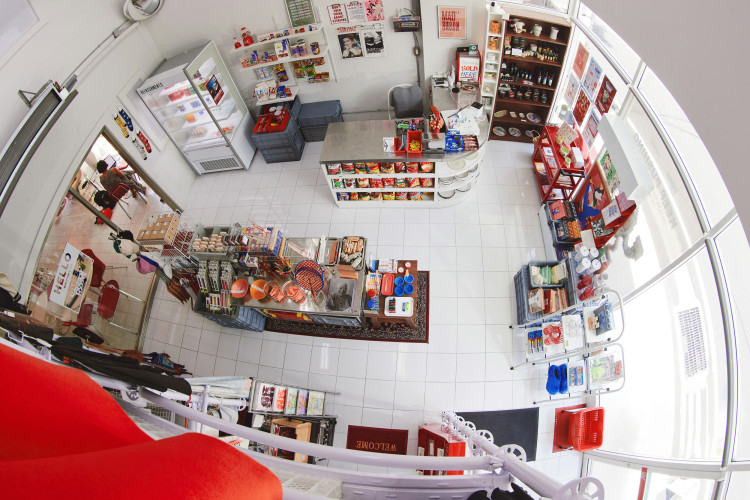
Like so many young artists looking to make it, big social media platforms are Gab Bois’s cheat code. Specifically Instagram, where she’s grown both her practice and exploded in popularity in just a handful of years. Even so, her rapid rise almost happened by accident.
Training to become a teacher at Université du Québec à Montréal, Canada, Gab began experimenting with objects and creating images with unusual perspectives and then posting them to Instagram. Back then, it was all just for fun. The idea to turn it into a full time career never even crossed her mind. As recently as 2016, she didn’t care much for social media and posted infrequently.
Then something pretty dramatic happened. While she was working part-time at a Christmas market, serving hot apple cider to tourists, one of her ‘weird collages’ went viral. She says the post was just another ‘spur-of-the-moment’ kind of thing. Almost totally unplanned. An image of an abstract woman with lipstick smeared across her eyelids, teeth and face. (A close-up of Gab in her bedroom, it turns out.) She edited the images on free software she found online, posted it, went to work and forgot about it.
‘It was freezing and I had these huge thick mittens on, so I couldn’t check my phone until the end of my shift,’ she says. ‘When I saw the notifications on the thing I’d posted just before clocking in, I was, like, what on earth is going on?’

She continues, ‘That whole night, I just kept refreshing it. I was super confused. But it made me think, okay, let’s try again. And the algorithm kept picking up more and more posts.’
Looking back, it’s not clear why this particular image became quite so popular. In her typically understated manner, Gab says she can’t make sense of it either. ‘Unfortunately, I don’t remember what the inspiration or idea behind it was. It’s hard to decipher what it even is.’
In some ways this makes sense. After all, have you ever seen a photo on Instagram and been unable to tell what’s real and what’s fake about it? It feels like most people on the platform have because, typically, Instagram is an app that thrives off the curated and the ambiguous rather than the authentic. Photoshop and Facetune can give anyone gleaming white teeth and rail thin legs (only the wavy bathroom tiles in the background reveal otherwise).
But we are becoming more attuned to the uncanny valley that is the grid. And the often surreal dissonance between real and fake, online and offline, is the space that Gab has been so successfully carving out as her niche.


Posting to her nearly 700,000 Instagram followers, Gab’s pieces are varied, eye-catching and bizarre. There are dresses made out of band-aids, sets of keys worn as earrings. There are necklaces made out of pretzels, heels made with forks or cigarettes. There’s the tiered birthday cake and corset made out of lettuce and kale. The flip phones that double as iridescent shells. Nothing, in other words, is quite as it seems.
‘A lot of people are super surprised by the fact everything is made in real life, except for maybe three photos I can think of that were significantly digitally altered, in a body of work that’s at this point over 300,’ she says from her home in Montreal.
‘Physically, sometimes it doesn't look as good. I'm not gonna lie, we use Photoshop to clean up some of the pieces. I think I've gotten fairly good at it with time, because you can’t really tell what's been cleaned up and how it was when it was first photographed.
‘But I've always loved illusions,’ she continues. ‘I think that illusion is kind of cool. I use post production to do finishing touches, but I really don't use it that much anymore. As a personal challenge I try to make the piece as final as possible before even starting to do post production. I think there's something so satisfying when you can look at a piece and be like, wow, I did it all with my hands.’

Soon enough, the traction on her account was so much that the nascent influencer-artist was able to postpone her studies and pursue her practice full time. ‘The way I was brought up, I was always very careful and safe when it came to career goals,’ Gab explains. ‘That's why I wanted to be a teacher. It's very straightforward. You very much know what to expect.’
Two years into her bachelors, though, Gab decided to take a semester off to ‘try out’ her art whilst keeping her retail job. It was tough. For 10 months, she worked while relegating her photography to evenings and weekends. ‘I still wasn’t making enough money to support myself full time, by a longshot.’
After a short spell working at an e-commerce clothing brand retouching photos – ending when the company went bust – Gab felt like the universe was giving her enough signs to develop her post-production skills and, finally, make the leap.
‘I thought, well now is the time to try to do this,’ she says. ‘Because at the time I was making decent money but also I didn’t have to take it seriously whilst working at a job, you know?’
Part of making ‘decent money’ comes from the way Gab utilizes her Instagram account as a shop window for brands. Brands – mainly European and American, although the artist herself still resides in Montreal, a small, ‘village like’ creative community she describes as supportive and inspiring – reach out to her through her platform. Recent collaborations include Desperados (a clutch bag crafted from a beer bottle), Apparis (a bomber jacket made from popcorn) and Marc Jacobs (a pair of shirts made from lettuce).


Just like her career, one of her very first brand collaborations – what she has since called a ‘huge one’ in terms of money and scale – almost happened by chance. In 2019, Gab made some braces out of Nike logos and uploaded the resulting image to Instagram. It went viral (with 30,000 likes, though some posts today hit 125,000). When the sportswear giant got in touch, Gab thought it spelled trouble. But rather than serving her a cease-and-desist, Nike wanted to buy the image and put it across t-shirts for an upcoming women’s collection.
Gab’s creative process hasn’t changed much over the past seven years. ‘The work is very ideas based. It all comes from a concept and then it's about finding the right mediums and materials to execute that idea,’ she explains. ‘Some of them don't translate well into photography, no matter how hard I try. Sometimes it'll translate better in a video, or as a sculpture, or as a physical piece that people can walk around and see from different angles.’
Some pieces and the resulting images take minutes. Others take days. ‘I made these candle holders with a pair of binoculars and some broken cameras, and they were super quick to make,’ she says.
‘The thing which took me the longest time was my scrabble tile dress – almost like a cocktail dress, sort of like chainmail, all these pieces connected together with metal hooks. Thousands of them that I had to drill holes in and then connect with the hoops and structure to fit me as a dress.’ It took three weeks to complete.

Nowadays, her work life looks very different to how it might have done had she stuck around in the classroom. Most days she heads to her studio in Montreal to work with her two assistants. She spends up to 10 hours there on weekdays (‘maybe five or six on weekends,’ she adds). The studio is a relatively new addition, one brought in the past 18 months as Gab’s practice has grown.
Looking ahead, she describes work on installations and larger-scale projects for new brands, like hotels and 250-people strong parties. Her days start early and finish late, but the process is collaborative and fulfilling. ‘It’s not lonely because I’m with my team in the studio,’ she explains, ‘and on the days I work from home, I speak to many people on video calls. So I never really feel alone.’
Even though we live in a world where creators are all fighting it out for the algorithm’s shrinking spotlight, Gab’s community includes other digital artists such as Nicole McLaughlin. ‘She’s been very inspiring from a behind-the-scenes point of view,’ says Gab, who also cites artist Judy Chicago as an influence. ‘There's a lot of overlap in our work, but Nicole and I have been able to join forces.’

Nearly all of Gab’s work revolves around static images, yet Instagram is increasingly prioritizing video via Reels (and many new creators are bypassing the platform completely in favor of TikTok).
Is she worried about this change in direction? ‘I mean, I'd like to think of myself as adaptable, but it has to make sense,’ she shrugs. ‘When the pandemic hit and TikTok was really, really blowing up for creatives, I can't even say that I tried it that much. I posted maybe just four or five TikToks. I was, like, you know what, I don't think this is for me. No disrespect to the platform or anything, but it's just not really a format that works, I don't think, for my work. I find the fast pace a little overwhelming to me as a consumer of content.’
There are other dangers to using social media, namely Instagram, to host an artist portfolio. The nature of the platform allows people to repost, screenshot and remove attribution. On top of that, the anonymous nature of the internet itself makes it easy for people to leave negative comments on your work, the kinds of comments there is no space or place for in, say, a traditional gallery setting (where people are less likely to stroll up to you and tell you how crap your work is).
‘It would happen so much at the beginning, because people really didn't know my style, and I wasn’t really out there in that sphere yet,’ Gab explains. ‘It would upset me. I felt really attached and close to the work that I put out. Whereas now I do feel a lot more detached from the work – not that I don't care about it, but more than that. It has a life of its own once it's posted, and that's fine. Like I can't be bothered trying to control that, in terms of interpretation or where it ends up.’


However, she continues, ‘If 1,000 people tell me in person that my work sucks, then I wouldn’t feel great. But I don't know how many people leave negative comments online. I can't be bothered with that stuff anymore.’
Her detached attitude to social media is impressive given how intertwined it is with her success as an artist. A lot of it is down to her ability to see her work how she did in the early days – simply as a creative outlet rather than real life.
Outside of working hours, Gab doesn’t spend much time online. ‘When I have a little bit of life left in me after a long work day,’ she says, ‘I go to watch movies that I can use as references in my work. But when I need to shut my brain off, I go for reality TV shows. I like spending time with my cat, going for ice cream or dinner with friends, going on a walk or to the gym, running errands or rearranging the furniture or decorations in my house.’
Today, there are fewer than 350 posts on the artist’s Instagram page. She is more inspired by the natural beauty of life in her native Canada than she is by the uber-curated beauty we find via infinite scroll. Surprisingly, perhaps, Gab seems to understand the power in logging off more than most of us.





